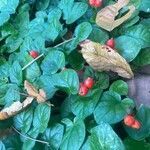Prostrate herbs, rooted at the nodes, the stems weak, the nodes well spaced. Leaves cordate, occasionally ovate rotund, (1.2-)1.7-4.5(-5.0) cm long, 1.3-4.2(-5.0) cm wide, obtuse, widely deltoid or rounded at the apex, basally cordate, auriculate, the auricles overlapping, the lateral veins 5, the 3 proximal veins arising from a common point, prominulous beneath, the veinlets inconspicuous, glabrous to scabridulous above, glabrous beneath except on the costa, usually with cystoliths on the lower surface; petioles 0.6-4.5(-6.0) cm long; stipules not seen. Inflorescences capitate with the peduncle 0.8-5.0(-8.0) cm long, glabrous to papillate at anthesis, the flowers few; bracts subulate, to 5 mm long, pilose, the outermost often with 2 short lateral lobes at the base. Flowers (in bud) with the hypanthium oblong or rectangular, ca. 1 mm long, glabrous, the calycine cup funnel shaped, ca. 0.8 mm long, glabrous outside and inside, eglandular within, the calycine lobes 5, subulate or lanceolate, ca. 3 mm long, slightly unequal, to 1 mm wide at the base, pubescent marginally; corolla white or orange, clavate in bud, to 7 mm long (10 mm long, fide Johnston), fleshy, petaloid, pubescent es-pecially at the apex outside, glabrous and with numerous raphides within; stamens 5, the anthers oblong, ca. 1 mm long, obtuse; style slender, the stigmatic lobes 2, short. Fruits red, ovate oblong, to 0.5 cm long; calyx cup and lobes persistent, to 3.5 mm long; seeds twisted and rugulose.
Creeping herb with stems 20-30 cm long, densely appressed pubescent, rooting at the nodes; leafy and flowering shoots reaching a height of 3-7.5 cm above ground-level. Leaf blades 1.2-3.6(5) x 1.3-4.3(56) cm, rounded-reniform, very rounded at the apex, emarginate-cordate at the base, glabrous above, glabrous or pubescent beneath; petiole 0.4-11.5 cm long, appressed or spreading pubescent; stipules transversely elliptic, almost truncate, 1.5 x 2-3.5 mm. Flowers not truly heterostylous, solitary, or more rarely up to 2 or even 3-5 in American material; peduncle 0.5-4.3 cm long, pubescent; bracts 1-2, lanceolate, 2.5-4 mm long. Calyx tube 1.2-2 mm long, obconic, pubescent; limb tube 0.8-1.2 mm long; lobes 1.5-3 x 0.5-0.7 mm at base, lanceolate. Corolla white; tube 0.5-1.3 cm long, cylindrical, finely pubescent; lobes 4-9 x 2-5 mm, oblong-elliptic; basal part of limb funnel-shaped. Anthers and style included, the latter 3.5-7 mm long; stigma 0.25-0.5 mm long, either level with or reaching beyond the anthers. Berries globose, bright red or orange, glossy, glabrous, 0.5-1.2 cm in diameter, crowned by the persistent lobes. Pyrenes greyish or straw-coloured, 3.5-4.1 x 3-3.5 mm wide, semi-ovoid, dorsal side convex, rugose, ventral side flat, rugose, with a narrow impressed smooth annular area where the 2 sides join. Seeds with chestnut-coloured testa easily removable to show the white endosperm, 3 x 2.8 x 1 mm, lenticular, smooth.
Herbs, perennial, creeping; stems quadrate to subterete, puberulent or hirtellous to glabrescent, vegetative creeping, 40 cm or longer, reproductive ascending, to 15 cm tall. Petiole 1-5 cm, densely puberulent to pilose or hirtellous often in lines; leaf blade drying membranous to papery and sometimes yellowish green, ovate to suborbicular, 1-3 × 1-3 cm, glabrescent on both surfaces, base cordulate to cordate, margins often undulate, apex obtuse to rounded; secondary veins 2 or 3 pairs, usually grouped in basal half of blade; stipules broadly ovate, 1-2 mm. Inflorescence with flowers 1-3 in umbelliform cymules, puberulent to hirtellous or glabrescent; peduncle 1-4 cm; bracts linear to narrowly triangular, 1.5-3 mm. Calyx glabrous to puberulent; ovary portion ellipsoid, 1.5-2 mm; limb deeply lobed; lobes 4, linear-lanceolate, 2-3 mm, ciliate. Corolla pilosulous to glabrescent outside; tube ca. 8 mm; lobes 4, ovate or ovate-lanceolate, ca. 3 mm, acute. Drupes red, subglobose to ovoid, 4-6 mm in diam., pilosulous to glabrescent; pyrenes dorsally weakly rugulose. Fl. Jul-Sep, fr. Sep-Dec.
A herb. It creeps along the ground. It has underground stems or rhizomes. It forms roots at the nodes. The stems are 20-30 cm long. They have flattened hairs. The flowering shoots are 7.5 cm high. The leaves are kidney shaped with a round tip. They are 3.5 cm long by 5.5 cm wide. There can be some hairs underneath. The leaf stalk is 11.5 cm long. The flowers usually occur singly. They are white. The fruit is a berry. It is 5-12 mm across. It is shiny orange-red when ripe. It has the remains of the calyx at the top.
Leaf blades 1.2–3.6(5) x 1.3–4.3(5.5) cm., rounded-reniform, very rounded at the apex, emarginate-cordate at the base, glabrous above, glabrous or pubescent beneath; petiole 0.4–11.5 cm. long, appressed or spreading pubescent; stipules transversely elliptic, almost truncate, 1.5 x 2–3.5 mm.
Pyrenes greyish or straw-coloured, 3.5–4.1 x 3–3.5 mm. wide, semi-ovoid, dorsal side convex, rugose, ventral side flat, rugose, with a narrow impressed smooth annular area where the 2 sides join.
Flowers not truly heterostylous, solitary, or more rarely up to 2 or even 3–5 in American material; peduncle 0.5–4.3 cm. long, pubescent; bracts 1–2, lanceolate, 2.5–4 mm. long.
Creeping herb with stems 20–30 cm. long, densely appressed pubescent, rooting at the nodes; leafy and flowering shoots reaching a height of 3–7.5 cm. above ground-level.
Corolla white; tube 0.5–1.3 cm. long, cylindrical, finely pubescent; lobes 4–9 x 2–5 mm., oblong-elliptic; basal part of limb funnel-shaped.
Anthers and style included, the latter 3.5–7 mm. long; stigma 0.25–0.5 mm. long, either level with or reaching beyond the anthers.
Calyx tube 1.2–2 mm. long, obconic, pubescent; limb tube 0.8–1.2 mm. long; lobes 1.5–3 x 0.5–0.7 mm. at base, lanceolate.
Seeds with chestnut-coloured testa easily removable to show the white endosperm, 3 x 2.8 x 1 mm., lenticular, smooth.
Berries globose, bright red or orange, glossy, glabrous, 0.5–1.2 cm. in diameter, crowned by the persistent lobes.
Creeping prostrate herb
Fruits scarlet
Flowers white

